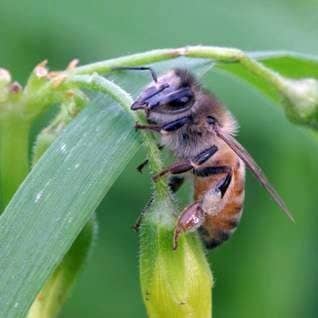
A dwarf bee also builds one – a single honeycomb somewhat larger than half a palm on a branch of a rare bush, right under the open sky. The top part of the honeycomb covers the branch on which it hangs, and at this point it is somewhat enlarged, forming a small horizontal surface on top – the dance floor of a small community! Here, the returning gatherers sit down, and here they broadcast their messages, based on the language of the dances of our honey bees, but they dance solely on the top platform of the honeycomb, on a horizontal surface from which they can see the sun and the blue sky.
If you use any tricks to force the pickers to move to the vertical surface of the honeycomb, their dances become extremely chaotic and disoriented. They are not at all able to translate the angle between the direction to the feeder and the direction to the sun at the angle of the wobbling run with respect to the direction of gravity. They can indicate the direction to the source of the bribe, only being on a horizontal platform and becoming relative to the sun at the same angle, under which they flew to the source of the bribe. In exceptional circumstances, our bees do the same, so we consider this behavior to be simpler and more ancient. Dwarf bees stopped at this stage of evolution and did not develop further. To constantly see the open sky, they had to come to terms with tropical rainstorms, from which their dwelling is completely unprotected.
So the study of the relatives of the honey bee made it possible to obtain some information about the way in which the honey bee could develop its amazing “language”. The first big step along this path was, of course, the separation from the excited but aimless running around the cell of the directional run of the dancers, who are preparing for a new flight and pointing out to others its direction, like a bird, which even before departure pulls its neck in that direction, in which is going to fly.
The study of the method of orientation allows us to conclude that, in this case, as well as during the flight itself, the bees seem to be guided by the position of the sun. But what explains that in a dark hive they translate the solar angle into a corner relative to the direction of gravity? Indeed, beehive families could not once come together and work out a single key for such a transfer: the direction upwards on the saute means the direction to the sun when flying.
Experiments carried out on other insects made it possible to clarify this process somewhat. The dung beetle, if it plays the role of a test animal, in order not to get off the straight path, is also guided by the position of the sun. He does it simply. When he crawls on the ground, he adheres to a certain direction in relation to the sun or an artificial light source.
If it is suddenly transferred to the darkness and made so that the surface over which it runs takes a vertical position, it immediately starts moving at the same angle to the direction of gravity, under which it moves in relation to the light source. For him, this has no biological significance: perhaps, due to some kind of peculiar instinct, he always moves at a certain angle with respect to the source of light. If the light disappears, the beetle is guided by some other factor, in this case in the direction of gravity. Corresponding phenomena are observed in other insects.
So, the transposition of the solar angle to the honeycomb – an ability that is difficult to explain – obviously was not adopted on the bee board. It is much more likely to assume that there is a widespread feature of the nerve centers laid down in their very basis.
The second big step in the development of the language of bees was made when this innate ability to encode found an expedient application: the ability to pass on to other bees direction information obtained from its own experience. In this unique way this feature was placed at the service of biological tasks.
This sounds very convincing – and at the same time remains mysterious enough not to cease to amaze.
Пчела-осмия. Улей лежак содержание пчел.
Breeds of bees